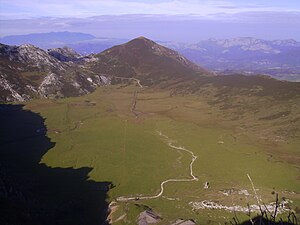Poljé
A poljé (from the Slavic, polje: field) is a depression in a large karst rock massif in the form of an elongated and closed valley, with a bottom flat, large and irregular contours. The edges are steep and limestone outcrops on them. It owes its presence to the dissolution modification of faulted or down-folded limestone blocks. It is usually traversed by a stream that suddenly disappears into a drain or pónor. The poljé can be temporarily flooded (or permanently, becoming a lake) if the surface water exceeds the drainage capacity of the pónor and other crevices and drains, or if it raises the groundwater level.
The flat bottom of the poljé is usually upholstered with terra rossa, a clay made from softening limestone. They are usually very fertile valleys as they function as sediment traps.
Poljés in Spain
- One of the largest poljés on the Iberian peninsula is in the Llano de Zafarraya, province of Granada (Spain). It is situated inside the mountainous mountain range of Sierra Gorda.
- Another of the most representative poljés is Vega de Comeya, in Asturias (Picos de Europa). It is one of the most visited by the wide range it presents and the very characteristic form it acquires when surrounded by mountain ranges.
- Another example visited and studied by geologists and geomorphologists from around the world is that of Matienzo in the municipality of Ruesga (Cantabria),
- The poljé de la Nava in Cabra (Córdoba), in the natural park of the Sierras Subbéticas.
- Also in Cantabria is the poljé of the municipality of Liendo, between the mouths of the rivers Asón (ria de Treto) and Agüera (ria de Oriñón).
- In the Serranía de Ronda (province of Malaga) the Llanos de Líbar, among the municipalities of Benaoján, Montejaque, Cortes de la Frontera and Villaluenga del Rosario, stand out for their large dimensions.
- In the Basque Country is the poljé of the Aizkorri mountain range, in the Aizkorri-Aratz natural park, located in the Urbía countryside. The mountaineering, the fonda and the hermitage of Urbía, the pastoral atmosphere and the spectacular landscape that it presents throughout the year make it one of the most visited places in the community. Located between the provinces of Álava and Guipúzcoa, the Urbía countryside span approximately 800 hectares, at a height of between 1 000 and 1 100 meters.
- In the province of Soria we have the Poljé de Conquezuela in an environment full of pre-Roman settlements, megalithic monuments and a spectacular country camp of elephant hunters.
- In the Natural Park of the Sierras de Cazorla, Segura and Las Villas, province of Jaén, stand out the poljés de Navalasno and Cañada de la Cruz, in the area of the Campos de Hernán Perea, which constitute the largest and highest calcareous platform of the Iberian peninsula, with 144 km2 and an average altitude of 1,697 m.
Contenido relacionado
Volcanic cone
Fortin Municipality
Infant


